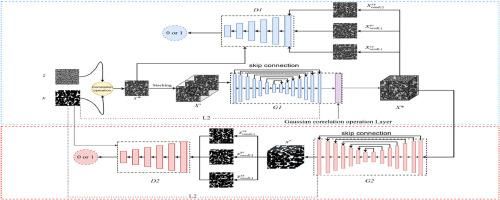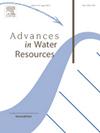Boosting the reconstruction performance of 3D Multi-porous media using double generative adversarial networks
IF 4
2区 环境科学与生态学
Q1 WATER RESOURCES
引用次数: 0
Abstract
With the continuous improvement of mathematical modeling technology, reconstructing the three-dimensional structure of media from two-dimensional reference images has become an important research method for the three-dimensional modeling of multi-porous media. Deep-learning-based methods are currently popular and form the focus of this research field. However, the performance of deep learning in reconstructing the three-dimensional structure of media from two-dimensional reference images still requires improvement. To enhance the diversity and generalization of network-generated three-dimensional models, this study proposed a preprocessing method that correlated two-dimensional reference images with Gaussian noise, a three-orthogonal random section constraint method, and a dual generative adversarial network (DGAN)-based model. Multiple sets of core samples, a set of building materials, and a set of battery-material samples were used to verify the performance of the proposed network. Both intuitive morphological and statistical feature comparisons showed that the DGAN model solved the problem of insufficient diversity and generalization when reconstructing three-dimensional porous media from a single image using deep-learning-based methods. The morphological and statistical features of the reconstructed three-dimensional structure also exhibited good consistency with the reference two-dimensional image, and the training efficiency of the network was greatly improved.

利用双生成对抗网络提升三维多孔介质的重建性能
随着数学建模技术的不断进步,从二维参考图像重建介质的三维结构已成为多孔介质三维建模的重要研究方法。基于深度学习的方法目前比较流行,也是这一研究领域的重点。然而,深度学习在从二维参考图像重建介质三维结构方面的性能仍有待提高。为了提高网络生成的三维模型的多样性和泛化能力,本研究提出了一种将二维参考图像与高斯噪声相关联的预处理方法、一种三正交随机截面约束方法和一种基于双生成对抗网络(DGAN)的模型。多组核心样本、一组建筑材料和一组电池材料样本被用来验证所建议网络的性能。直观的形态和统计特征比较表明,DGAN 模型解决了基于深度学习的方法从单一图像重建三维多孔介质时多样性和泛化不足的问题。重建后的三维结构的形态特征和统计特征与参考二维图像也表现出了良好的一致性,网络的训练效率大大提高。
本文章由计算机程序翻译,如有差异,请以英文原文为准。
求助全文
约1分钟内获得全文
求助全文
来源期刊

Advances in Water Resources
环境科学-水资源
CiteScore
9.40
自引率
6.40%
发文量
171
审稿时长
36 days
期刊介绍:
Advances in Water Resources provides a forum for the presentation of fundamental scientific advances in the understanding of water resources systems. The scope of Advances in Water Resources includes any combination of theoretical, computational, and experimental approaches used to advance fundamental understanding of surface or subsurface water resources systems or the interaction of these systems with the atmosphere, geosphere, biosphere, and human societies. Manuscripts involving case studies that do not attempt to reach broader conclusions, research on engineering design, applied hydraulics, or water quality and treatment, as well as applications of existing knowledge that do not advance fundamental understanding of hydrological processes, are not appropriate for Advances in Water Resources.
Examples of appropriate topical areas that will be considered include the following:
• Surface and subsurface hydrology
• Hydrometeorology
• Environmental fluid dynamics
• Ecohydrology and ecohydrodynamics
• Multiphase transport phenomena in porous media
• Fluid flow and species transport and reaction processes
 求助内容:
求助内容: 应助结果提醒方式:
应助结果提醒方式:


